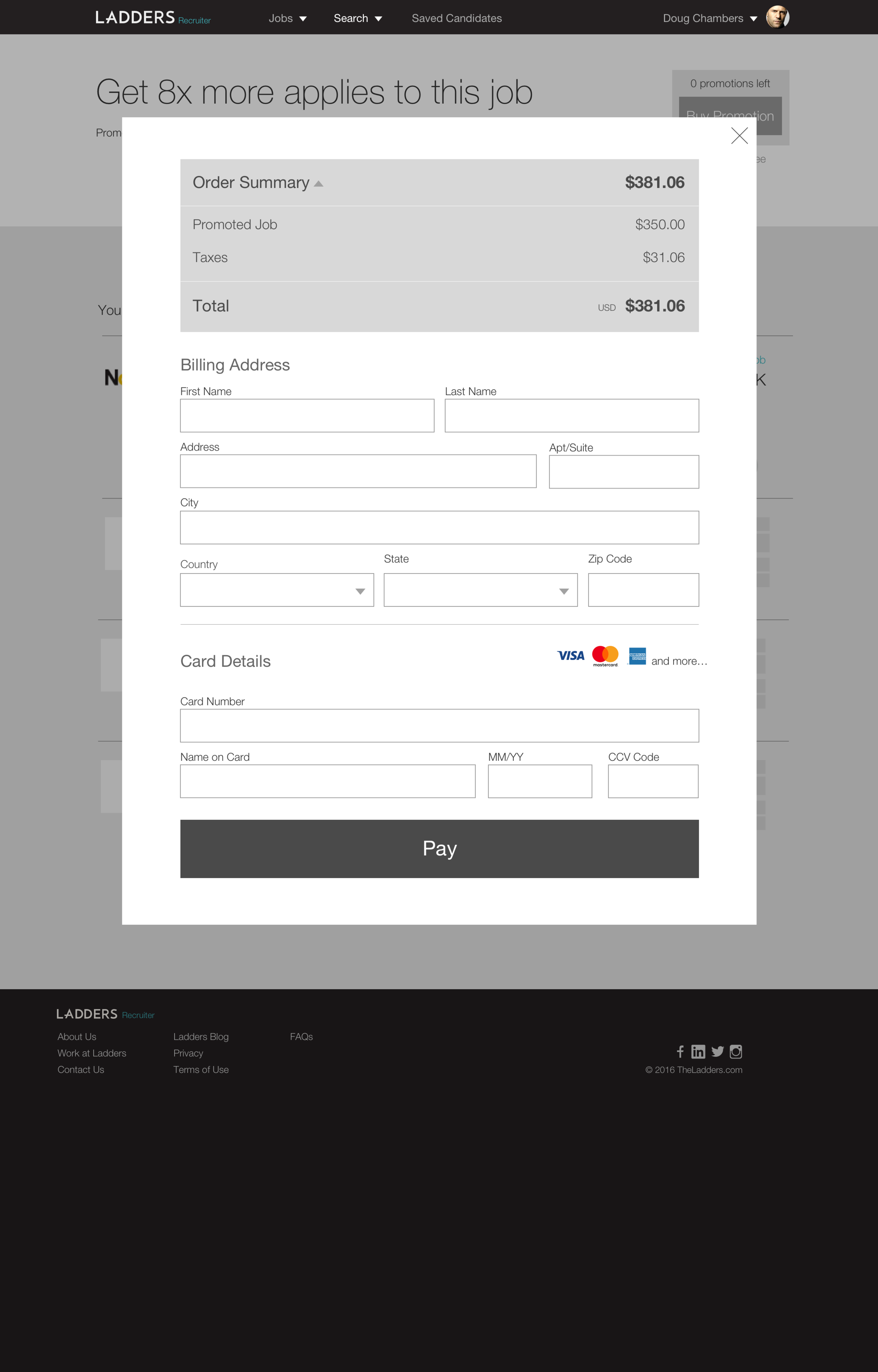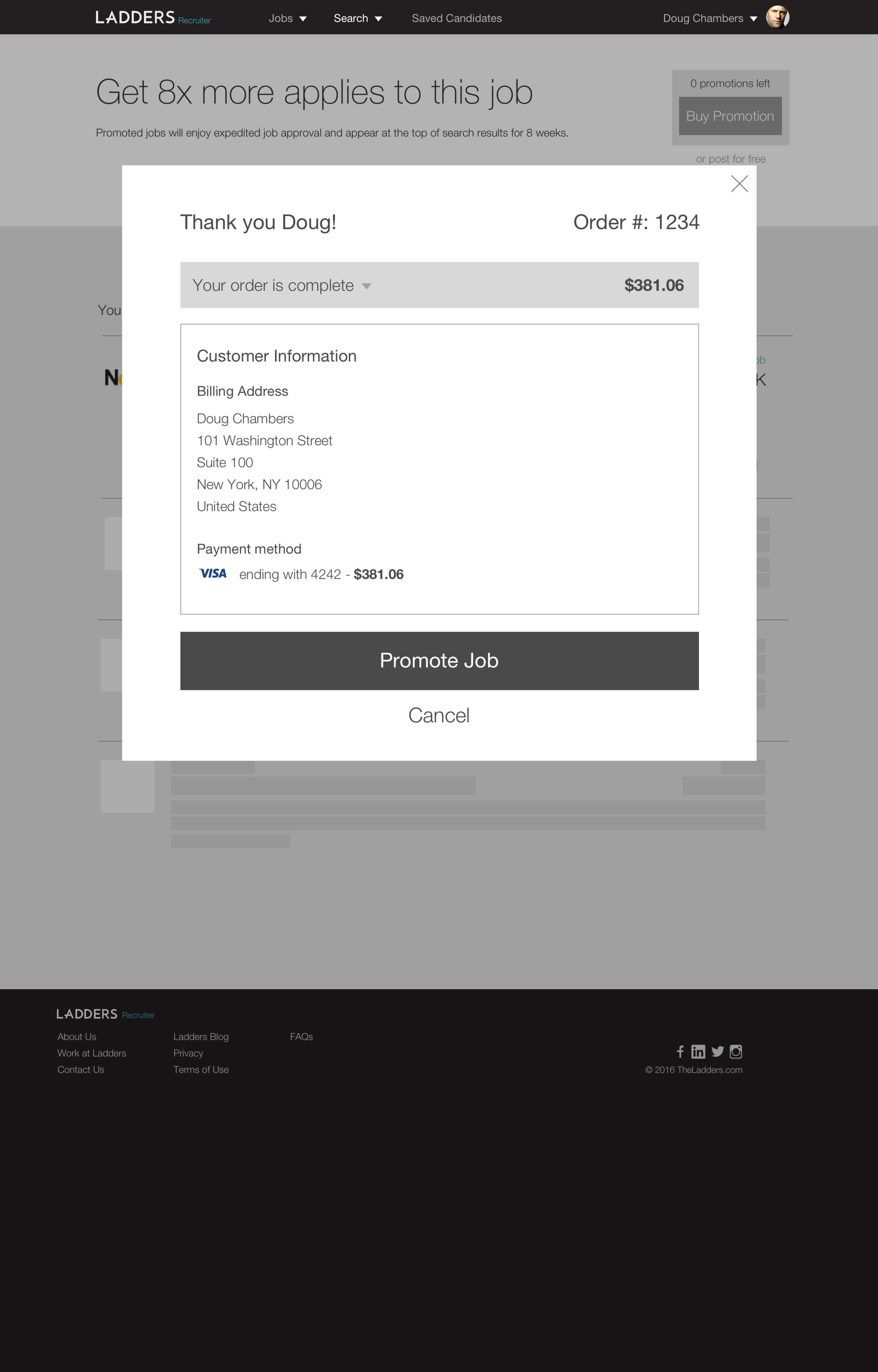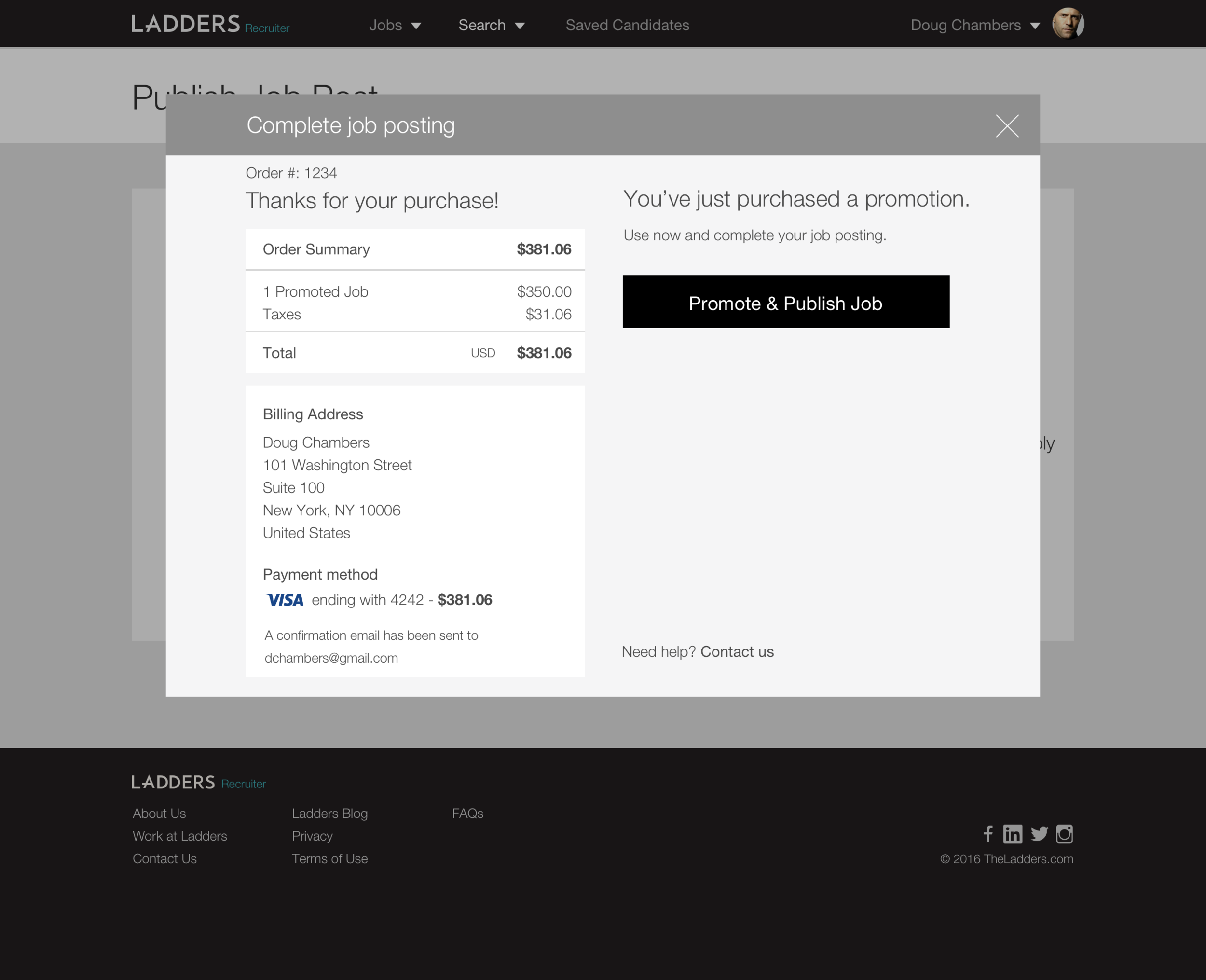PromotE JOB LISTINGS on LADDERS
Creating an experience for recruiters to promote jobs on Ladders.com
As of May 2017, the unemployment rate in US is 4.3%. Recruiters are finding it harder and harder to find qualified candidates and there are more unfilled positions. According to a 2017 Recruiter sentiment study conducted by the MRI Network, 63% of Recruiters answered that there are not enough qualified candidates.
I was asked to create a feature to allow recruiters to promote their crucial jobs on Ladders so their postings stay on the top of search results. Job promotions are a paid feature that act as a supplement to the free postings on Ladders, helping recruiters get those difficult to fill positions in front of more eyes and giving them peace of mind so they can move on to other tasks.
MY ROLE
I led the research, concept and design, usability testing and ensured the implementation of all the features related to Job Promotions product. I worked along with a product manager and a small team of engineers.
the design process
starting with Research
there's still a need for job boards
I attended the Sourcecon recruiting conference and participated the Job Board workshop hoping to learn about more about new tech, competitors and tricks of the trade. To my surprise, the first thing that was discussed was around the topic of how Recruiters felt about job boards. To many of the Recruiters present, job boards seemed to something from the past and there are newer and faster methods of finding candidates.
However, sourcing from job boards is a tried and tested method of finding candidates and the session taught me that job boards are still used because:
- Still the #1 source of hires
- Part of a wider sourcing strategy - cover all bases
- Easy to use
- Gives recruiters more time back to source
- Indeed/Monster/Careerbuilder - 358 million visitors per month with an avg duration of 4.6 minutes
- Helps to promote employer brand
- Problem is not the job board, it’s the job description (everything else is based on this)
Recruiter's perception of Job boards. (Sourcecon 2017 and Google)
Posting a job takes care of the low hanging fruit
In addition from what I learned about Recruiter's perception of Job boards, from my own user research, I found that posting a job is considered to be low hanging fruit in the list of to-do's within the Recruiter's search process. It is one of the first tasks that a Recruiter takes care of when they have a new position. Striking it off the list of list allows a Recruiter to move on to the more tedious and time consuming tasks of sourcing passive candidates while they wait for applicants (active candidates) to trickle in. Since job promotions should help bring in more applicants, it would provide an extra peace of mind especially to the recruiters where sourcing is not their primary job function (Post and Pray persona).
Job posting activity on ladders
Taking a look at data, we see that 68% of the jobs on Ladders are reposted, sometimes jobs are reposted up to six times and the majority of jobs are reposted twice. This indicates that we should also prioritize and incorporate the job promotion process within the job re-posting task. However, we need to take into account that a large percentage of the Recruiters on Ladders consist of Agency type Recruiters. The reposting behavior in that case could be related to posting of generic jobs to fill candidate pipelines for similar positions, in this case, the chances of promoting a job is not high.
Data from 2017
How do our competitors do it?
While Promoted Job listings is new to Ladders, it's not a new concept to the recruiting world. Both Linkedin and Indeed have allow companies to sponsor job postings while a job posting is being created.
What I learned from the research
While there are many ways to find candidates, posting a job on a job board is still one of the most effective ways that requires the least effort. Providing a Recruiter (whoever it may be., e.g. Sourcer, HR professional, Hiring Manager, etc.) multiple ways, multiple access points and reminders to promote their job is crucial.
TESTING THE VIABILITY
Since Promoted Job listings is a new paid feature on Ladders, we want to test for interest before building out all the flows. For ease of integration and implementation, the engineering team decided to set up a ecommerce shop via Shopify. Recruiters would purchase job promotions via the ecommerce shop but they need to speak to a Ladders sales rep to get their job promoted.
This created a whole new pain point and a disjointed experience for the Recruiter and also for our internal operations team (Sales and Account Managers).
WHAT WE LEARNED
What we learned from this test is that this is a product that our customers would pay for on Ladders and that there are technical challenges involved such as promoting a job while the job is in a pending approval state and the limitations of Shopify (e.g. not able to store credit card numbers for repeated use.)
MAPPING THE EXPERIENCE ON LADDERS
POINTS OF ENTRY
Moving forward with this project to design a contiguous experience, it was necessary to identify all the points of entry for the job promotion process. These are the scenarios whereby someone might have a need to promote a job.
1. JOB POSTING PROCESS
The most logical place for a recruiter to promote their job posting is via the post job flow. The initial thought was to ask users to promote their job on the Job Preview page. When you're drawing a flow, you don't always think about all the content that needs to fit on the page. I would need to incorporate an advertisement for Job Promotions which would be distracting to the task at hand which is to preview and examine the job posting for errors.
2. Manage Jobs Page
Another place a recruiter can promote their job is within the Manage Jobs page. This is another logical place because this is where a recruiter reviews the performance of their job postings on site. Each job that is posted is reviewed and approved/rejected by Ladders, a process that takes less than an hour. At this point, the job is in a pending approval state. After the job is approved, it's under the active state which means that it's active on site and searchable by job seekers for 8 weeks. Under this design, the Recruiter will be able to promote their job under both states.
A question came up when designing the promotion of an active job. How long will a promotion last if a job is promoted at week N of being active? To simplify the implementation, it was decided that the job promotion will extend the life of the job, essentially reposting the job for another 8 weeks.
3. Job performance Email
What we learned from user research was that recruiters may not promote their jobs at first. Depending on the urgency of the job, they may choose to initially create a free posting and based on the performance of the posting, they may promote it at a later point. To remind users about their job's performance and nudge users to promote their job, an email will be sent to the recruiter after N days if their job did has not reached N applicants.
4. Job reposting PROCESS
From what we learned from usage data, we know that a large percentage of jobs are being reposted, although they could be from Recruiting Agencies. We still need a way to allow Recruiters to promote their job when they're reposting it on site. Jobs that are reposted will go through the same manual validation and approval process as newly created jobs on Ladders, thus we can utilize the same pages designed in the job posting process.
Visualizing how it would all work together
DESIGNing CONCEPTS and usability testing
For the purpose of this case study, I will only be illustrating the process of purchasing a promoted job whilst posting a new job.
DECISION PAGE DESIGN AND TESTING
Recruiters will get to this page when they're posting a job. They will have the ability to purchase a job promotion or redeem a job promotion via this page. The components of the page are:
An advertisement for a job promotion
An indication of the number of promotions remaining for use
A Purchase CTA
An example of a promoted job
I thought about when this decision could be made and a logical place would be after the job preview page. I tested various designs and messaging (see the two examples below).
In the design on the left, recruiters were confused about the visual example of a promoted job and they wasn’t sure about their progress. The design on the right addressed those two concerns however, recruiters didn’t understand some of the messaging around job promotion and question how we arrived at the “8X more applicants” number.
Final design
Final design that was implemented.
Purchase flow
Working within the constraints of Shopify, we were limited to a three step modal flow. The original concept called for a three step stacked modal but this was not technically feasible using Shopify. The second concept, a one page checkout, is also not feasible due to Shopify constraints. The third concept is also not feasible because the final step of completing the credit card information and publishing the job is also not technically feasible. Since these were standard checkout patterns, there were no issues found during usability testing. Users were all able to complete the task of purchasing a promoted job.
PROBLEMS AFTER LAUNCH
The usability issue identified after launch resulted in Recruiters not completing the last step of the process which was to publish and promote the job. The modal headline was updated to indicate that there is a last step remaining and the promote job button was moved so that it's front and center.
Initial Outcome
Sales of promoted jobs doubled in the first two weeks of launch. Additional A/B testing of the promotion ad is scheduled to optimize sales of job promotions via flow.
Reflections
learn and iterate
This was an aggressive project with a short timeline and many constraints based on the tech platform (engineers learning and developing in re-frame and creating single page apps without tracking requirements) and limitations of Shopify (iframe, credit card number can't be saved). It was necessary to iterate fast and get things tested and into the hands of developers. Following the 80/20 rule when testing for usability sometimes left me feeling a bit uneasy but due to the pace, I had to let go and monitor performance in the production environment. Without GA tracking, the only way I could determine if there were usability issues was through monitoring Hotjar recordings. I was able to quickly identify usability issues and get them addressed ASAP. The moral of the story is that you can't get everything right the first time, especially when you're a User Reseacher and Designer of one on your team. This is only the first iteration and we will definitely be iterating based on feedback and conversion metrics.
A new team
At the same time, I was working with a new team of developers who were new not only to re-frame but to Ladders and the Recruiter product. At times they seemed to by working in silo and working on parts of the process which impacted other parts of the process without understanding the full picture. At a time like this, it was really important for me to take charge and walk everyone through the wireflows and prototypes and be present to answer any questions to make sure that things are moving and not blocked due to a poor understanding of the design.





















